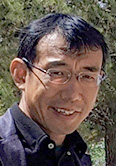Outline of Project E01
Exploration of quantum gravity and quantum matter based on symmetry and information geometry
The University of Electro-Communications,
Graduate School of Informatics and Engineering

In recent years, Resource Theory of Asymmetry (RTA) has been rapidly developing a comprehensive analysis of the effects of symmetry on quantum mechanics. RTA treats quantum operations which are covariant with respect to given symmetry as free operations, and defines the quantum fluctuation of conserved quantity corresponds to the given symmetry as resource. Recently, I found several trade-off relations in RTA (PRL2018, QIP2020, PRL2021, etc.). The goal of this project is to unify and extend the trade-off relations and apply them to find several useful theorems in quantum gravity and condensed matter theory.
The results obtained to date include a universal trade-off structure between symmetry, irreversibility, and quantum coherence. This trade-off particularly reveals that (1) under a global symmetry, any attempt to induce local dynamics that change the conserved quantity will cause inevitable irreversibility, and (2) such irreversibility could be mitigated by quantum coherence. This relation admits broad applications including measurement, error-correction, gate implementation, thermodynamics, and black hole physics. For example, we apply our relation to black hole physics and obtain a universal lower bound on how many bits of classical information thrown into a black hole become unreadable under the Hayden-Preskill model with the energy conservation law. This particularly shows that when the black hole is large enough, under suitable encoding, at least about $m/4$ bits of the thrown $m$ bits will be irrecoverable until 99 percent of the black hole evaporates. In the future, I aim to extend and apply these results more and more.
Study of physically natural method to generate t-design in quantum many-body systems based on quantum control theory
Department of Computer Science,
Faculty of Informatics, Shizuoka University

Random unitary transformation is one of the central techniques in quantum information processing. In early stages of quantum information processing research, random unitary transformation based on Haar measure is used. Here, Haar measure is a regular invariant measure on the unitary group. However, it was recognized that the implementation of the random unitary transformation based on the Haar measure requires exponential time. Therefore, unitary t-design, a measure that approximates the Haar measure, has attracted much attention. A t-design are not only essential for various quantum information processing, but have recently been found to be important as a method for approximating quantum chaotic systems and for Markovizations of environmental systems.
Existing t-design generation protocols are designed as polynomial-time algorithms that work efficiently on a quantum computer. However, it difficult to implement them on a quantum many-body system. In this project, we are focus on finding a physically more natural way to generate t-designs in quantum many-body systems than existing methods, with applications such as Markovianization and quantum chaos in mind. First, by applying the techniques of quantum control theory, we prove the existence of a random control method such that the random dynamics of the whole system is t-design in a fully controllable quantum system. In a quantum many-body system, it is natural to assume a situation in which a random action is externally applied only to the restricted degrees of freedom. Therefore, by using the random control method proved above, we show that t-design of the whole system can be achieved by random unitary transformations to small subsystems in well-known one-dimensional and two-dimensional spin systems. Furthermore, we aim to apply the obtained new t-design generation method to quantum information processing. In particular, by creating parametric quantum circuits based on the new method, we aim to devise a new quantum many-body device that can perform variational quantum algorithms by accessing only a part of the system.
Information-theoretical analysis of one-dimensional tensor network
Department of Mathematical Informatics,
Graduate School of Informatics, Nagoya University

Tensor networks are an efficient representation to describe quantum many-body states or operators with a small number of parameters. They are widely used in ExU researches too, to analyze the dynamics of quantum many-body systems and the holography principle. The use of tensor networks has been spreading to various fields of physics in recent years, but even in relatively simple cases such as one-dimensional (1D) networks, there are still many unresolved aspects in the theoretical foundation.
In this publicly offered research, we will clarify what kind of quantum states can be described by 1D tensor networks, called MPO. In 1D systems, two major types are known: MPS and MPO (there is also another type called MERA, but we do not discuss it here). It is theoretically known that the quantum states that can be efficiently represented by MPS coincide with the low-temperature states (ground states) of 1D systems. This indicates not only that MPS is suitable for describing low-temperature states, but also that MPS is not suitable for describing other states, which is a limitation of MPS's expressive capability. In contrast, MPO is a tensor network suitable for describing thermal states in 1D systems. However, it is known that the states described by MPO include states beyond that, and it is not clear to what exactly the physical states described by MPO. The problem of the description range of tensor networks is not well understood except for MPS, and this research will tackle this unsolved problem for MPO as a first step.
Interestingly, MPO is also related to the physics of 2D spin systems. It has been pointed out that the physical properties of 2D noncritical systems at low temperatures are reflected in the 1D system at the boundary of the system. The 1D state at the boundary is described by MPO, so we plan to address the "holographic" correspondence between such 2D low-temperature states and 1D thermal states in the latter half of this proposal.
Development of quantum many body system out-of-equilibrium and quantum information control with NMR
Department of Physics, Nagoya University

Nuclear spins weakly interact with electron spins through hyperfine interactions in the energy scale of MHz-GHz. The hyperfine interactions include a variety of information associated with the electronic structure and symmetry. Our research group utilizes nuclear magnetic resonance (NMR) as the local probe of symmetry breaking and low energy excitation in condensed quantum matters by determining and solving the hyperfine interaction. Our target materials are the system having macroscopic quantum entanglements such as quantum Hall effects and quantum spin liquids without showing conventional long-range orders. These states can carry anyons with fractional statistics, which are important for the fault-tolerant quantum computation. Our aim is to observe such an emergent quasiparticle by NMR spectroscopy. Although the quantum Hall effect has been realized only on two-dimensional systems, the recent discovery of three-dimensional Dirac semimetals having linear energy dispersion opens the door for magnetic studies by NMR etc. Indeed, we have observed the quantized motion of Dirac fermions in the NMR relaxation rates at high fields and low temperatures. In quantum spin liquids, there is no electric charge carrier but spin excitation. It has a topological order with the long-range quantum entanglement for a gapped spin liquid case analogous to the quantum Hall regime. We have found some candidate materials exhibiting as quantum spin liquid in frustrated spin systems. Can nuclear spins mediate the long-range entanglement of electrons? In this project, we will develop the new open quantum many-body system by combining the macroscopic quantum states and nuclear spins, which is useful to read out the quantum information.
Generation of graph states using cold Rydberg atoms and the application to measurement-based quantum computation
Institute for Molecular Science

In this research, we will perform an experiment to generate many-body entanglement states, called "graph states," which are important resources for quantum error correction and measurement-based quantum computation, via natural time evolution with the interaction between cold Rydberg atoms.
In the cold-atom experimental platform, it is possible to construct a qubit array with the optical tweezers array technique, where locally focused laser beams are used to trap each atom individually and arrange them in an arbitrary shape. Long-range interactions can also be induced between atoms by exciting them to a highly-excited electronic state called a Rydberg state. In this experiment, we produce a large-scale entanglement over the atomic qubit array and generate the graph state via a time evolution under the long-range Ising interaction between atoms.
We excite cold Rubidium atoms trapped in an optical tweezers array to the Rydberg state by pulsed lasers, which induce Ising-type long-range interactions between the atoms and time evolution to generate large-scale entanglement over the atomic qubit array, creating the graph state. By using pulsed lasers to excite the atoms in a short time compared to the time scale of the atomic interactions, we can ignore the Rydberg interactions during the excitation, subsequently inducing interactions between the atoms simultaneously, while continuous wave lasers are generally used in the Rydberg excitation. This is different from the conventional method of performing two-qubit gates for each individual qubit pair and forming entanglement sequentially. We investigate the optimal Rydberg electronic states, state manipulations, and graph geometries for graph state generation. We characterize the fidelity of the generated states by combining single-site addressing single-qubit gate operations.
In addition, we implement individual local measurement that does not affect other atoms in the neighborhood, and explore the possibility of using the generated graph states as a resource for measurement-based quantum computation.

